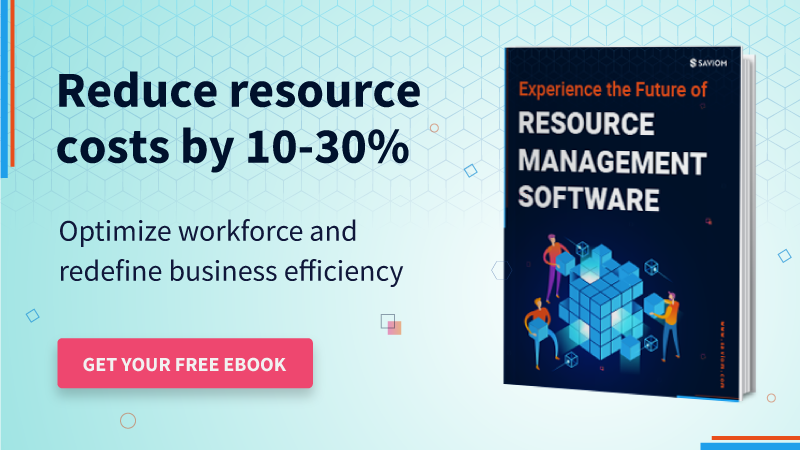Resources are the most significant investment for most businesses. A business must utilize its resources most efficiently and intelligently when facing a highly competitive and volatile global market.
Many project-intensive businesses use either silos of spreadsheets or some home-grown tools for scheduling their resources. These solutions are incredibly limiting, time-consuming, and hard to maintain. It creates double bookings, over/underutilized resources, undesirable hiring/firing, low staff morale, improper planning of pipeline projects, etc.
To achieve your limited resources’ full potential, a business must establish an enterprise-level mature resource scheduling process.
This guide has been designed for businesses to get a comprehensive understanding of resource scheduling systems to establish the right processes with the right tool.
What is resource scheduling?
Resource scheduling is the most crucial part of the resource management process. It involves identifying and allocating resources for a specific period to various types of activities.
Resource scheduling is the process of assigning resources such as people, equipment, materials, and facilities to various tasks for a specific period. These activities can be related to project work or non-project work, i.e., BAU, Support, admin, operation, etc.
The main objective of resource scheduling is to ensure that the right resources are available at the right time to meet project deadlines and achieve business objectives.
Project managers estimate the resource requirements needed to meet the deliverables and request the same from resource managers who complete the initial allocation.
In short, resource planning and scheduling is crucial for streamlining resource and project management processes.
Types of resource scheduling methods
Below are the two main types of resource scheduling methods:
Resource-constrained scheduling
The resource-constrained scheduling method is primarily used when an organization has limited resource availability. The goal is to ensure that the project deliverables are completed efficiently without overloading existing resources. It involves adjusting the start and finish dates of tasks to ensure optimal utilization of resources throughout the project lifecycle.
For example, a software development project requires a senior programmer who is only available part-time due to other commitments. To accommodate this constraint, the project manager can alter the timeline of tasks that require the programmer’s expertise based on their availability. Thus, optimizing the project schedule based on the resource capacity ensures that the tasks are delivered as per expectations while maintaining quality.
Time-constrained scheduling
The time-constrained scheduling method is primarily used to manage resource constraints in projects with strict deadlines. In this approach, the project timeline is considered a critical factor, and the goal is to ensure that the project is completed within the specified deadline.
For example, in a construction project with a fixed completion date, the project schedule may be organized in such a way that key resources are first assigned to critical tasks. This ensures their availability and avoids scheduling conflicts. Moreover, managers can also add additional resources to keep the project schedule on track.
Now that we know the types of scheduling, let’s learn about its importance.
Importance of resource scheduling in project management
Every project is an integration of multiple tasks that require certain niche skills to produce tangible results. The onus is on project and resource managers to ensure that the right resource is working on the right task. Or else, it may deteriorate the project quality and also reduce employee productivity.
At the same time, the manager has to keep in check the availability of the workforce. For instance, if one critical resource is booked for multiple projects simultaneously, it will cause over-utilization, eventually leading to burnout.
Adding to that, if the resource’s skills do not align with the project tasks, it will compromise the project’s quality and lead to employee dissatisfaction. These factors contribute to a low resource health index.
Moreover, every project has a definite timeline, and it’s the project manager’s responsibility to ensure that the project is delivered on time and within budget. If the resources are not scheduled before the project initiates, it will result in delays in task execution and, in worse cases, may even bring the project to a halt.
However, suppose managers take a systematic approach to schedule the resources. It will ascertain that resources’ skillset is in-line with their tasks and their utilization is as per their capacity. This will also enable project managers to document a well-defined work breakdown structure with a systematic resource plan in place.
Additionally, modern resource scheduling solutions provide data-driven foresight into various resource metrics like resource availability, capacity vs. demand gap, utilization, etc. Based on this, managers can implement the right resourcing measures and eliminate potential bottlenecks.
Overall, intuitive resource scheduling in project management ensures the timely delivery of projects and within budget enhancing client satisfaction.
Given the importance of resource scheduling in a project environment, let’s discuss its benefits.
How does modern resource scheduling & planning benefit businesses?
An effective workforce scheduling system can resolve several challenges faced by modern businesses with the matrix organization. It will provide immense benefits in the following areas:
Maintains and elevates project quality
Having the right person with the right skills is crucial for a project to finish within budgeted time and without disrupting the quality. Therefore, applying the right resource scheduling methodology helps project managers achieve the same by identifying and allocating a competent person.
In the absence of proper scheduling practices, managers will resort to allocating the first visible resources to project tasks. This may lead to the assignment of under or overqualified resources, resulting in budget and schedule overruns. Moreover, skill mismatches can jeopardize the project quality and result in low client satisfaction.
Ensures timely delivery of projects
Project resource scheduling has two major benefits. Firstly, it facilitates the competent allocation of resources during the project planning stage. When skilled employees are assigned to tasks matching their competencies, it guarantees better quality of work and reduces the risk of errors.
Secondly, it allows project managers to schedule the resources for critical tasks in advance. This ensures the availability of niche-skilled professionals for project initiation. Thus, proactive resource scheduling enables managers to avoid last-minute firefighting and facilitate smooth project execution and on-time delivery.
Allows uniform scheduling with enterprise-wide visibility
A robust resource scheduling system can help organizations achieve 360-degree visibility into the enterprise talent pool and its attributes, such as competencies, roles, cost rates, experiences, locations, departments, etc. It also allows supervisors to foresee ongoing and pipeline resource demand, both project and non-project work.
Moreover, the tool provides visibility into resource calendars, including upcoming vacations, PTOs, paid leaves, etc. Such a granular view of resources empowers managers to facilitate uniform scheduling, ensuring that resources are assigned to tasks based on their skills and capacity.
Empowers proactive capacity planning with data-driven foresight
The system’s multi-dimensional forecasting capabilities can provide foresight into resource demand for pipeline projects. It helps managers gauge the upcoming project requirements against the existing workforce capacity to identify short and long-term resource excess/deficits.
Based on this analysis, managers can create a comprehensive capacity plan to address and bridge the gap. For instance, they can adjust project timelines, retrain current employees, or hire a contingent workforce ahead of time. Therefore, the system empowers proactive capacity planning, helping firms mitigate skill gaps and maintain an optimized workforce.
Enhances productivity with optimal resource utilization
Modern resource scheduling systems can forecast billable and strategic utilization of the workforce ahead of time. The tool leverages real-time Business Intelligence and advanced analytics to analyze past and present project data to create realistic resource estimates for future opportunities.
Therefore, it can help managers mobilize employees from non-billable work to billable or high-priority projects to maximize profitable utilization. Moreover, they can bring forward future projects, sell resource time aggressively, or restructure capacity in different areas to avoid capacity wastage and ensure optimal utilization levels.
Reduces project costs ahead of time with real-time financial reports
The system can track critical project financial indicators like resourcing cost, revenue, profit margins, and overheads. It provides reports such as forecast vs. actual that allow organizations to identify financial anomalies and take corrective action to control project costs ahead of time.
For instance, managers can analyze the cost rates of the employees and create an optimal band mix to reduce project resourcing costs. By maintaining a blended combination of senior, junior, interns, and niche-skilled resources, managers can keep projects on track while ensuring higher deliverable quality.
Helps leverage the shared-services model and deliver more projects with fewer resources
Modernized businesses leverage a shared-services model to optimize their operational efficiency and minimize overhead costs. Such a model emphasizes active cross-team collaboration and engagements, allowing firms to deliver more projects despite resourcing constraints.
With the ability to update data in real-time and maintain a centralized data repository, a modern scheduling tool allows seamless management of a shared-services model.
Moreover, it enables project managers to recruit inter-departmental resources from the internal channels rather than incurring additional hiring costs.
Read More: 7 Powerful Benefits of Resource Scheduling for Project Managers
In the following section, we’ll learn about the challenges that come with using legacy tools for resource scheduling.
What are the challenges of traditional resource scheduling techniques?
Most project-centric businesses are fighting against pertinent resource management challenges of the 2020s with systems developed in the 1990s.
It is valid for all types of companies irrespective of size, market share, or market reputation. The tools listed below are some examples of legacy systems:
- Silos of spreadsheets built with macros
- Home-grown half-baked systems
- Windows-based systems of the 1990s
- Entry-level resource scheduling system
Most of these outdated legacy tools have the following challenges:
Easy to develop but difficult to maintain
The ease of developing manual processes, such as updating siloed spreadsheets, often comes at the cost of long-term maintainability. Manual processes are prone to errors, and they cannot be updated in real-time. Over time, as projects evolve, maintaining these siloed spreadsheets becomes increasingly complex.
Furthermore, the lack of automation hampers efficiency, and the risk of inaccuracies grows, undermining the reliability of the data repository. Therefore, what seemed like a convenient solution at the onset transforms into a hindrance in the long haul.
Paying a high price for lost market opportunities
Due to the absence of multi-dimensional forecasting and capacity planning, managers fail to manage resource requirements for pipeline projects effectively. Thus, some critical project positions remain vacant when the project is initiated, eventually compelling the managers to give up the project.
Thus, businesses pay a high price for not having the foresight into upcoming resource needs, impacting their ability to capitalize on emerging market trends and potentially losing out on lucrative projects due to insufficient planning.
Unable to provide forecasting and capacity planning
The legacy tools cannot predict the resource metrics and provide data-driven foresight. This inability to forecast resource demands for future projects creates a significant gap in strategic planning.
Managers find themselves without a comprehensive resource capacity plan, making it challenging to align workforce capabilities with upcoming project requirements. This increases the chances of project failures and also results in client dissatisfaction.
Read More: Resource Forecasting Guide for Project Managers
Not designed for improving profitable utilization & cost reduction
Since legacy tools cannot forecast billable and strategic utilization of resources in advance, managers resort to unplanned hiring/firing cycles to meet project demands. Moreover, lack of real-time visibility hampers their effort to manage resource under/overloading and optimize utilization rates.
This reactive approach not only increases project resourcing costs but also diminishes the opportunity for managers to implement cost-effective measures. Furthermore, the inability to align resource planning with strategic business objectives further limits the organization’s ability to enhance profitability and operational efficiency.
Unsuitable for matrixed organization structure
The challenges posed by disparate spreadsheets and siloed data are exacerbated in a matrixed organizational structure. The inherent limitations of these tools hamper the efficient functioning of a matrixed organization, where seamless coordination and data transparency are paramount.
Decision-makers find it increasingly difficult to maintain a single source of truth, resulting in effective collaboration across various departments. Therefore, it often results in data duplication, information silos, and inefficient workforce utilization.
Unable to deliver real-time business intelligence
Most home-grown tools do not have advanced business intelligence capability that can provide real-time tailored reports on every resource KPI. Therefore, organizations purely rely on guesstimations and approximations. Unfortunately, this can increase the risk of project failures.
Without real-time business intelligence, firms are unable to adapt to changing circumstances, identify emerging trends, or capitalize on new opportunities. This lack of agility and responsiveness compromises the organization’s competitive edge in a dynamic business landscape.
Now that the challenges of scheduling are clear let’s understand the factors that one must take into account during project resource scheduling.
Factors to consider in resource scheduling
A resource scheduler can consider several factors that can help expedite resource scheduling and make it effective. Here are a few prominent factors to look into while scheduling resources.
Project requirements and objectives
During resource scheduling, one must consider the project’s specific requirements and objectives. It involves determining the scope, deliverables, and goals to understand the type and quantities of requisite resources to accomplish the project.
Resource availability and capacity
Another crucial factor to consider for a resource scheduler is the availability and capacity of resources. Factoring in the factors like shifts, vacations, etc., is also essential as they can impact resource availability to ensure resources scheduled are actually available when required.
Skill sets and qualifications
A resource planner must consider the skills, qualifications, competencies, expertise, knowledge, certifications, experience, etc., to ensure resources have the potential to execute the assigned tasks effectively.
Dependencies and constraints
The resource planner must find out the task interdependencies, constraints, or limitations that can affect the resource scheduling. Creating a critical path for a complex project can also help identify task interdependencies in project resource management.
Read More: What Project Interdependencies Span Your Portfolio?
Project timelines and deadlines
A resource scheduler must also consider project timelines, duration and sequence of tasks, and deadlines. Considering milestone completion dates and critical deadlines is also vital to ensure resource allocation aligns with project scheduling and tasks are completed on time.
Budget and cost considerations
Last but not least, a resource scheduler must also factor in account budget and cost considerations. They must consider the costs of various resources, such as professionals, labor, equipment rentals, raw materials, etc., and optimize resource allocation to stay within the budget.
Given the factors to be considered while scheduling resources, the following section describes the best practices to make project resource scheduling effective.
Best practices for efficient project resource scheduling
Resource scheduling is not only about plugging the hole by scheduling or allocating resources against the projects. It goes much beyond this process.
A comprehensive resource scheduling system includes enterprise-wide resource scheduling, forecasting, capacity planning, utilization management, tracking actuals, etc.
Form a WBS to create task dependencies and create schedules as per resource competency
Pre-planning is essential for project managers to eliminate potential bottlenecks and unnecessary delays. One of the major tasks is to get the right resource for the project tasks.
Managers can do this seamlessly by creating a work breakdown structure that defines all the project’s nitty-gritty and defining task dependencies along with the skills required. Once the details are in place, managers can schedule resources with the right competencies for the bifurcated project tasks.
Leverage resource optimization techniques to manage projects better
Often project managers are caught in a situation where the resources who are allocated the tasks from the critical path aren’t available. With an overview of their availability, managers can use the resource booking software and implement resource optimization techniques like resource leveling or resource smoothing. It will adjust the project timeline based on resources’ availability or pull-in more resources from across departments to complete one task.
Read More: Project Resource Management: An Ultimate Guide on How to Master it
Centralize enterprise resource or workforce scheduling
The system should provide a single schedule for the whole enterprise to establish a single source of truth. For example,
- Resource allocation and scheduling can be done in real-time by multiple stakeholders
- Agile resource allocation can be achieved with easy drag and drop
- The schedule can be viewed in numerous ways in a matrix organization structure
- Ensure there is no double booking
Manage the project delivery in a complex matrix organization
Most of the large organizations have now moved into a matrix reporting structure that has multiple dimensions. The resource scheduling system provides visibility of people’s information across the complex matrix organization structure and controls the rights to modify them. It ensures that no resource falls through the cracks and also facilitates project managers to allocate cross-functional resources and ascertain seamless project delivery.
Track competencies in real-time and allocate the right people to projects. It is critical to keep competency information up to date. The right people are assigned to the right project across the enterprise based on skill, experience, qualifications, location, cost rate, etc. This information can be updated by the concerned user, which can be validated before accepting it. Moreover, competent resource allocation is the stepping stone to faster project delivery and an efficient project management process.
Read More: Resource Allocation: A Guide on How to Apply it to Project Management
Forecast workforce utilization to increase profitability
The system should provide short- or long-term forecasting of billable, strategic, and overall workforce utilization. So that corrective actions can be taken to protect the effective utilization and profitability of your business. As a result, the stakeholders managing different dimensions can foresee the information required to make the right decisions.
Streamline resource capacity planning to bridge the gap
Advanced software should forecast capacity vs. demand from multiple perspectives, i.e., by role, department, team, location, skills, etc. It helps you identify short or long-term shortages/excess of resources ahead of time and reduce undesirable hiring/firing decisions.
Foresee pipeline project demands and plan ahead of the curve
The system should keep track of future project requirements to ensure that your resource pool is optimally balanced and skilled. It will also make it ready to meet the demand of projects in the opportunity pipeline or approval pipeline. It will help in planning hiring or training-related decisions ahead of time.
Track actuals against forecast for future improvements
A comprehensive system should help you keep track of actual time spent against the estimates. So that future forecasting can be improved and aligned to reality. It will also help you monitor shared resources who are working on multiple activities.
Project managers can also benefit from forecast vs. actual reports. They can implement data-driven measures to mitigate the deviation in the actual and forecasted numbers and combat the project roadblocks.
Ensure effective bench management to minimize bench-time
One of the most important factors to be taken care of is bench management. A project resource scheduling software should predict the resources which are likely to end up on the bench. It will enable managers to allocate the next project tasks to the employees before their current project finishes. It will reduce their bench time and help you find the right resource through internal channels, saving hiring costs.
Read More: What is Resource Planning, and Why is it Important in Project Management?
How can resource scheduling improve profitability & productivity?
Resources scheduling can help a business unleash human resources’ full potential and significantly improve profitability and productivity.
Reduce Project Resourcing Costs
With the help of efficient resource management, overall resourcing cost can be reduced drastically:
- Eliminate under/over skilled resources on projects
- Utilize cost-effective global resources without compromising quality
- Avoid last-minute hiring cost through with proper capacity planning
- Reduce unplanned attrition
Minimize hiring/firing cost
Hiring/ firing costs can be reduced by using workforce forecasting and capacity planning. Forecasting enables proactive smoothening of project workload and reskilling employees. Frequent Hiring/Firing creates a negative image for the organization for attracting new talents. It is also an expensive exercise and affects the existing employees’ morale.
Enhance profitable utilization
A business can improve profitability by implementing strategic and billable utilization across the enterprise using effective resource management. As a result, valuable and critical resources do not get assigned to the lesser important projects or activities.
Improve employee productivity
Resource management can improve employee productivity significantly:
- Employees having work allocated as per their competencies and area of interest
- Resources being able to work on different types of projects across the business
- Staff being reskilled to bridge future resource capacity gaps
- Employees being empowered in the early decision-making process
Read More: The Effects of Low Productivity on Business Growth
What should you look for in an ideal resource scheduling software?
Resource scheduling is crucial for the performance improvement of modern business. So, a business should not just look for a solution that replaces the current spreadsheet functionalities. It should go much beyond that and ensure that they have a solution that can provide the following:
A workflow-based resource requisition process
Project Managers often get caught up in the endless loop of email trails to request niche resources from the resource managers. This time-consuming method can cause delays or sometimes even cost you the project. Thus, a modern resource scheduling tool in project management should have an automated resource requisition process. It will streamline the method and also keep every stakeholder, decision-maker on the same page.
Scenario-based what-if analysis
When resources are limited, juggling them between projects to fulfill dynamic project requirements is quite common. Applying different workforce optimization techniques on simulated business scenarios helps visualize and compare various impacts. One can either extend timelines or mobilize resources to a high-priority project before arriving at the best outcome under the given constraints.
Scalable, configurable, and expandable
Every business is different, and so are its resource management needs. You can’t have one size fits all. That is why a business should select a scalable, configurable, and expandable tool to meet future business needs.
Procures Real-Time metrics report
Resource demand in a real-life business environment changes every minute. So, it is crucial to gain real-time business intelligence and reports for informed decision-making. Moreover, real-time reports and analytics help project managers monitor and control progress at all times.
Provides data-driven foresight
Resource management solutions should allow your business to do multi-dimensional forecasting over and above scheduling. It also provides real-time business intelligence to improve business performance, profitability, and productivity.
Allows seamless management of matrix structures
Nowadays, most businesses have established a matrix organization structure to achieve the best utilization of their workforce. So, it is critical for a business to have a software system that aligns with its matrix organization structure.
Integrable with other systems
Most businesses have already invested in enterprise-level systems holding quite a bit of data required by a resource management system. This specific information can be a resource profile, competencies project detail, etc. So, the resource management system must integrate seamlessly with existing systems.
Read More: How to Select the Best Resource Management Solution for your Business
Conclusion: – dos and don’ts of scheduling
Dos
- Stay updated with initial resource allocation, availability, and utilization before scheduling more projects.
- Create a resource band mix keeping in mind the project budget and leverage the global shared-services model.
- Analyze the capacity vs. demand gap in advance and implement appropriate resourcing measures to bridge the gap.
- Use advanced features of a resource scheduling solution to filter and search for the right resource for the right job.
- Stay forewarned of future project demands to ensure systematic management of pipeline projects.
- Schedule generic resources for future project tasks to specify the resource demand and book an actual resource once he/she is available to take up the job.
- Conduct upskilling and training programs for benched/lesser-experienced resources to allow them to take up more opportunities down the line.
- Schedule resources to different functional projects to enable and empower them to explore new areas and grow professionally.
- Compare actual vs. forecast utilization and note the deviation to improve resource scheduling for future projects.
Don’ts
- Don’t use silos of spreadsheets to create resource schedules as it may lead to double-booking and overutilization.
- Do not book highly-specialized resources for low-priority tasks. It will lower down their morale and productivity and increase costs, and other critical projects will suffer.
- Refrain from booking resources to a project that they are not interested in. It will reduce their engagement, and they will not be able to use their skills to the maximum extent. It will impact both employees’ and resources’ performance.
- Avoid under and over-allocation of resources, as they both can lead to unplanned attrition.
- Do not book the resources for 100% of their capacity, as their 20-25% time might be utilized for admin meetings, and so on. Keep a buffer to set realistic deadlines.
The Glossary
Read More: Glossary of Resource Workforce Planning, Scheduling and Management
SAVIOM Solution
SAVIOM is the market leader in providing a futuristic solution for the effective management of resources. It has more than 20 years of experience working with high valued global companies around the world. SAVIOM also provides tools for project portfolio management, professional service automation, and efficient workforce planning. So, SAVIOM can help your business to establish an efficient system geared towards your specific business challenges.













